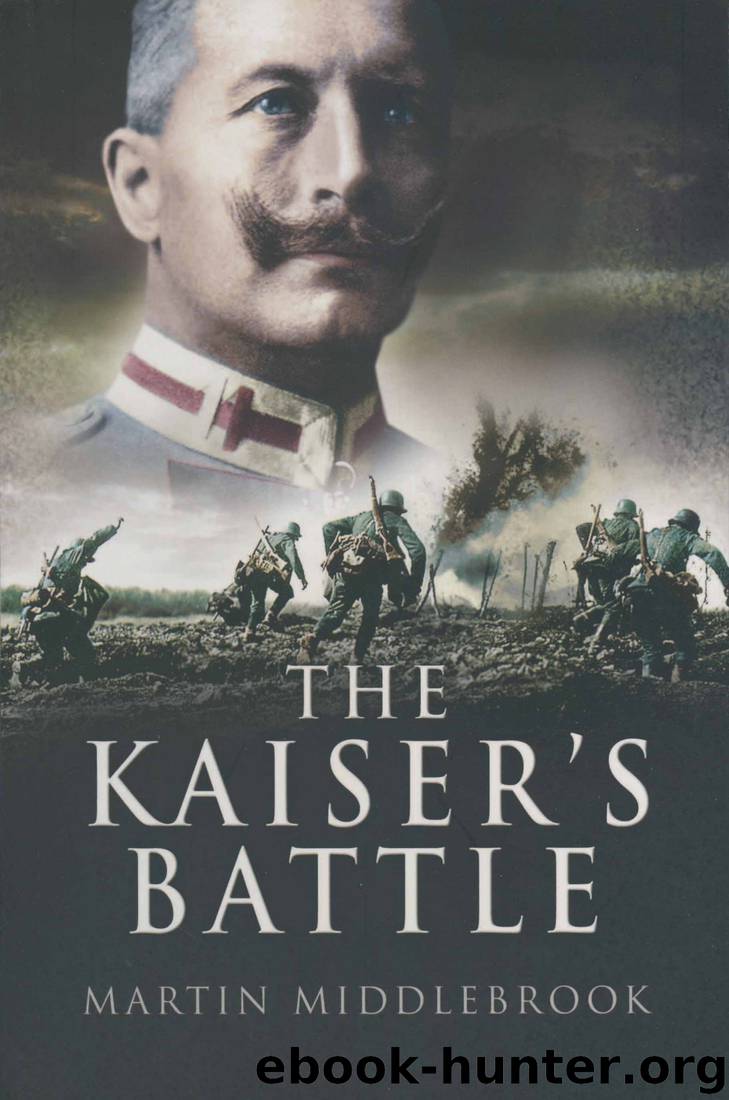The Kaiser's Battle by Martin Middlebrook

Author:Martin Middlebrook [Middlebrook, Martin]
Language: eng
Format: epub
Tags: new, fix
ISBN: 184415498X
Google: bnR-AwAAQBAJ
Amazon: 184415498X
Goodreads: 1380868
Publisher: Pen & Sword
Published: 2000-11-15T05:00:00+00:00
9
* * *
* * *
The Fight for the Battle Zone
It was upon the defence of the Battle Zone that the main hopes of the British commanders rested. The defences here consisted first of a strong, continuous trench line – known as the Red Line – well protected with barbed wire and commanding good fields of fire over the open ground across which the Germans, who had earlier swept through the Forward Zone, had to advance. In the area behind the Red Line were many independent infantry positions, heavy machine-gun and trench-mortar posts, and artillery positions. At the rear of the Battle Zone was a second continuous trench – the Brown Line – about 2,000 yards behind the front of this defence zone. That last line of trenches represented the final substantial defence work between the Germans and the open ground which extended to the coast sixty or seventy miles away. There was supposed to be a further line – the Corps, or Green, Line – but hardly any work had been done on this. Even the Brown Line was not complete in the Fifth Army area.
The British garrison in the Battle Zone positions represented about half of the strength of the forward divisions. The remaining units in these divisions had either been in the Forward Zone or were behind the Battle Zone forming part of the slender reserves available to the local corps commanders. The remainder of the corps reserves were made up of the few reserve infantry divisions available, the dismounted cavalry and a few tank battalions. It was vitally important for the British to hold on to the Battle Zone and these reserves were to be used to counter-attack any part of the defences taken by the Germans or to fill any gaps appearing in the defences. Behind the reserves were only the many vulnerable administrative units found behind every fighting army.
The units holding the Battle Zone had all been able to man their positions before the preliminary bombardment ended but the German storm troops had swept through the frontline defences so quickly that, where the Battle Zone lay close behind, the Germans arrived within twenty minutes of the opening of their infantry attack. These early encounters with the Battle Zone defences usually took place before the dense fog cleared. The earliest fighting in the Battle Zone was on the high ground, near Ronssoy, which was held by the 7/8th Royal Inniskilling Fusiliers, 16th Division, and on the Louveral Ridge, held by parts of the 6th and 7th Black Watch, 51st Division. Thus, parts of the Battle Zones of both the Fifth and the Third Armies were being attacked, and breached, by 10 a.m., and many other parts of it were under attack within the next hour.
It must be stressed again that action in the two zones was often taking place at the same time but, while the Forward Zone soon succumbed in most sectors, the fight for the Battle Zone grew in intensity and it was to dominate the remainder of the daylight hours.
Download
This site does not store any files on its server. We only index and link to content provided by other sites. Please contact the content providers to delete copyright contents if any and email us, we'll remove relevant links or contents immediately.
| Africa | Americas |
| Arctic & Antarctica | Asia |
| Australia & Oceania | Europe |
| Middle East | Russia |
| United States | World |
| Ancient Civilizations | Military |
| Historical Study & Educational Resources |
The Radium Girls by Kate Moore(11622)
100 Deadly Skills by Clint Emerson(4694)
The Templars by Dan Jones(4558)
Rise and Kill First by Ronen Bergman(4547)
The Doomsday Machine by Daniel Ellsberg(4248)
The Rape of Nanking by Iris Chang(4024)
Killing England by Bill O'Reilly(3899)
Hitler in Los Angeles by Steven J. Ross(3799)
Stalin by Stephen Kotkin(3726)
12 Strong by Doug Stanton(3420)
Hitler's Monsters by Eric Kurlander(3164)
Blood and Sand by Alex Von Tunzelmann(3060)
Darkest Hour by Anthony McCarten(3019)
The Code Book by Simon Singh(2859)
The Art of War Visualized by Jessica Hagy(2840)
Hitler's Flying Saucers: A Guide to German Flying Discs of the Second World War by Stevens Henry(2625)
Babylon's Ark by Lawrence Anthony(2433)
The Second World Wars by Victor Davis Hanson(2422)
Tobruk by Peter Fitzsimons(2375)
